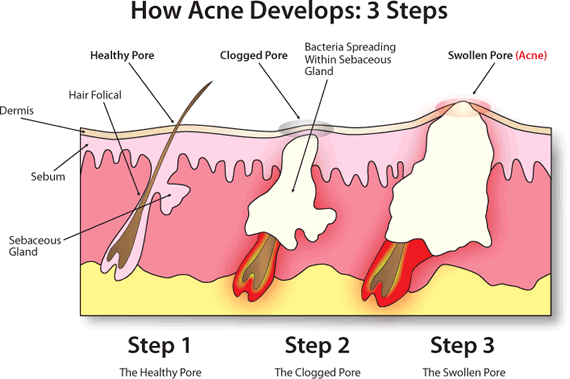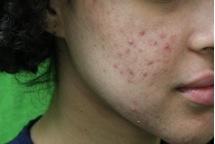Acne affects both men and women at various levels of severity. This medical skin disease, known as acne vulgaris, usually appears during puberty. However, acne can appear at any stage in life due to genetic reasons, hormonal fluctuations and lifestyle-induced factors. Acne presents itself with prevalent sebaceous follicles, typically on the face, back and chest.
The appearance of acne ranges from occasional flare-ups of a few pimples to chronic breakouts. Due to the range of symptoms, prevention and possible acne scar treatments are case specific.
ACNE CAUSATION FACTORS
Clogged follicles are the main contributors to acne. Lifestyle and environmental factors, such as makeup or excessive dirt buildup, are main culprits. Cellular level processes are also acne causation factors, such as genetics, stress, hyperkeratization and hormonal fluctuations.
Hormone fluctuations during adolescence, pregnancy, polycystic ovary syndrome, Cushing’s syndrome and menopause play a role in acne outbreaks and flareups. Two hormones that contribute to acne include insulin growth factor (IGF-1) and androgens. Androgens include testosterone, dihydrotestosterone and dehydroepiandrosterone sulfate.
Excessive sebum production is triggered by excessive androgen triggers. Excess sebum results in clogged pores. While IGF-1 stimulates the same glands involved, IGF-1 triggers result from diet choices that prompt more insulin production.
Genetics also contribute to acne. Those who develop acne at an earlier age that is much more severe than that of typical adolescence usually have other family members who had or have severe acne.
As for disorders that cause acne, hyperkeratization is one that triggers excessive keratin production of hair follicle interior linings. When cells in the area clump together and form blockages around the sebaceous duct, acne results.
Not surprisingly, stress is also a major acne contribution factor. Stress is taxing to the immune system and may result in acne breakouts. While a direct correlation is still unknown, sebum-producing cells have receptors for stress hormones.
Acne has five different types of “bumps” inclusive of:
- Nodules
- Papules
- Pustules
- Cystic lesions
- Comedones
ELIMINATING ACNE USING TOPICAL PRODUCTS, MEDICATION
Acne can be addressed with topical products, medication, lifestyle changes and laser therapy. Topical products are those that usually contain benzoyl peroxide. This may be in the form of cleansing solutions, lotions, creams and gel solutions. Topical products are generally effective for eliminating mild acne since benzoyl peroxide kills the bacterium P. acnes.
Topical or oral antibiotic medications may be effective for severe acne, though some dermatologists and doctors are curbing using antibiotics for acne solutions. Common antibiotics to treat acne include erythromycin, clindamycin and tetracycline. Oral contraceptive as part of hormonal regulation may also be used in women to reduce androgen levels
Other options include topical retinoids, such as tretinoin (Retin-A), adapaline (Differin) and tazarotene (tazorac). These retinoids assist to regulate and normalize follicle cycles. Once follicle cycles are managed, excess sebum production ceases to minimize blockages.
Oral retinoids such as isotretinoin (vitamin A derivative) reduce oil secretion. However, this acne solution route is only used for severe acne issues due to numerous side effects and complications. Brand names include Accutane, Amnesteem, Sotret and Claravis.
ACNE SOLUTIONS USING PHOTOTHERAPY, LASER
Two other acne solutions for treating stubborn acne include phototherapy and laser treatments. Phototherapy uses light (red and blue, 405 to 420 nanometer) to generate free radicals within the bacteria. The light treatment causes acne-causing organisms to self-destruct
Photodynamic therapy (PDT) and Levulan is an acne solutions treatment that combines blue light (or the VBeam) with a topical photosensitizer. It addresses the root issues that causes acne and also rejuvenates skin. One of the most effective acne treatment solutions is with the use of lasers. Laser systems can effectively improve the appearance of acne scars, remove skin imperfections, eradicate wrinkles and improve overall skin tone and complexion.
Light waves from acne treatment solutions burn away the follicle sac and sebaceous gland so acne breakouts cannot occur. Laser skin treatments for acne also induce the formation of oxygen within the bacterial cells, which leads to their destruction.

acne can appear at any stage in life due to genetic reasons, hormonal fluctuations and lifestyle-induced factors. Image courtesy of www.qi-iq.org *
PHOTODYMANIC LIGHT THERAPY SOLUTIONS USING VBEAM, SPECTRA
Dr. Umar at FineTouch Dermatology offers photodynamic light therapy as a preferred acne treatment. Photodynamic light therapy has a high level of efficacy and less side effects than most acne treatment options. This simple treatment regimen schedule is weekly sessions over the period of four to eight weeks.
PDT with VBeam is used with Levulan, a topical photosensitizer applied 30 to 45 minutes prior to each therapy. Sessions utilizing the blue light are done at seven-day intervals for a total of approximately four treatments. Sessions utilizing the 585 to 595 nanometer laser are done each four weeks for a three to four treatment regimen. After PDT, sunburn-like effects are common and require patient downtime.
Dr. Umar’s preferred laser treatment is Spectra VRMIII laser for acne treatment solutions. Spectra is highly effective for treating both severe and cystic acne. This method involves three to four treatment regimens with each sessions performed every two to four weeks. After the first session, skin improvement concerning acne is usually noticeable. Acne typically clears by the end of the acne treatment regimen with Spectra. A six-month maintenance session is suggested with Spectra to prevent reoccurrence.
Dr. Umar offers consultations and solutions for acne treatments, in addition to treatment options for acne scars and numerous skin conditions.

